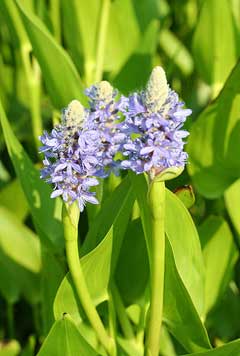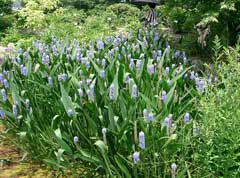 |
|
http://commons.wikimedia.org/wiki/User:Jean-Pol_GRANDMONT |
 |
| http://commons.wikimedia.org/wiki/User:KENPEI |
Translate this page:
Summary
Bloom Color: Blue, Lavender. Main Bloom Time: Early summer, Early fall, Late summer, Late spring, Mid summer. Form: Spreading or horizontal, Upright or erect.
Physical Characteristics

 Pontederia cordata is a PERENNIAL growing to 0.8 m (2ft 7in) by 0.5 m (1ft 8in) at a medium rate.
Pontederia cordata is a PERENNIAL growing to 0.8 m (2ft 7in) by 0.5 m (1ft 8in) at a medium rate.
See above for USDA hardiness. It is hardy to UK zone 3. It is in flower from July to September. The species is hermaphrodite (has both male and female organs) and is pollinated by Bees.
Suitable for: light (sandy), medium (loamy) and heavy (clay) soils. Suitable pH: mildly acid, neutral and basic (mildly alkaline) soils. It cannot grow in the shade. It prefers wet soil and can grow in water.
UK Hardiness Map
US Hardiness Map
Synonyms
Plant Habitats
Pond; Bog Garden;
Edible Uses
Edible Parts: Leaves Seed
Edible Uses:
Seed - raw, cooked like rice or dried and ground into a powder[55, 62, 106, 183]. A very acceptable nutty flavour and texture when raw, they are said to be excellent if the seed is lightly roasted in an oven[183]. Young leafstalks - raw or cooked[62]. The whole plant is edible cooked or raw[106]. It can be added to salads, cooked like spinach or added to soups[183].
References More on Edible Uses
Medicinal Uses
Plants For A Future can not take any responsibility for any adverse effects from the use of plants. Always seek advice from a professional before using a plant medicinally.
Contraceptive
An infusion of the plant has been used as a contraceptive[257].
References More on Medicinal Uses
The Bookshop: Edible Plant Books
Our Latest books on Perennial Plants For Food Forests and Permaculture Gardens in paperback or digital formats.

Edible Tropical Plants
Food Forest Plants for Hotter Conditions: 250+ Plants For Tropical Food Forests & Permaculture Gardens.
More

Edible Temperate Plants
Plants for Your Food Forest: 500 Plants for Temperate Food Forests & Permaculture Gardens.
More

More Books
PFAF have eight books available in paperback and digital formats. Browse the shop for more information.
Shop Now
Other Uses
References More on Other Uses
Cultivation details
Landscape Uses:Container, Specimen. A water or bog garden plant, it requires a rich soil[56] and prefers growing in water 15 - 30 cm deep[1]. Plants are hardy to about -25°c[187]. A very ornamental plant, it forms spreading patches by means of a thick creeping rhizome[187]. There is a species of bee (Dufourea novae-angliae) which visits this plant for nectar and pollen and does not visit any other species of plant[103]. The reproductive biology of Pontederia cordata has been well studied. It is a tristylous species, and most populations contain all three forms. At least some degree of self-incompatibility exists, being strongest with the short-style forms and weakest with the midstyle forms[270]. Special Features:Attracts birds, Attractive foliage, North American native, Grows submerged, Invasive, Naturalizing, Wetlands plant, Suitable for cut flowers, Extended bloom season in Zones 9A and above, Attractive flowers or blooms.
References Carbon Farming Information and Carbon Sequestration Information
Temperature Converter
Type a value in the Celsius field to convert the value to Fahrenheit:
Fahrenheit:
The PFAF Bookshop
Plants For A Future have a number of books available in paperback and digital form. Book titles include Edible Plants, Edible Perennials, Edible Trees,Edible Shrubs, Woodland Gardening, and Temperate Food Forest Plants. Our new book is Food Forest Plants For Hotter Conditions (Tropical and Sub-Tropical).
Shop Now
Plant Propagation
Seed - best sown as soon as it is ripe in pots standing in 2cm of water in a cold frame. Cover the seed lightly with silver sand. Submerse in 3cm depth of water after the seedlings emerge[200]. When they are large enough to handle, prick the seedlings out into individual pots and grow them on in water in the greenhouse for their first winter. Plant them out into their permanent positions in late spring or early summer, after the last expected frosts. Division is best in April but it can be done at almost any time of the year[1]. Very easy, larger divisions can be planted out direct into their permanent positions. We have found that it is better to pot up the smaller divisions and grow them on in light shade in a cold frame until they are well established before planting them out in late spring or early summer. Lateral shoots.
Other Names
If available other names are mentioned here
Native Range
NORTHERN AMERICA: China (Anhui Sheng, Gansu Sheng (south), Guangdong Sheng (north), Guangxi Zhuangzu Zizhiqu (north), Guizhou Sheng, Henan Sheng, Hubei Sheng, Hunan Sheng, Jiangsu Sheng, Jiangxi Sheng (northwest), Shaanxi Sheng (south), Shandong Sheng, Shanxi Sheng (south), Zhejiang Sheng) United States (Connecticut, Indiana, Maine, Massachusetts, Michigan, New Hampshire, New Jersey, New York, Ohio, Pennsylvania, Rhode Island, Vermont, West Virginia, Illinois, Iowa, Kansas, Minnesota, Missouri, Nebraska, Oklahoma, South Dakota, Wisconsin, Alabama, Arkansas, Delaware, Florida, Georgia, Kentucky, Louisiana, Maryland, Mississippi, North Carolina, South Carolina, Tennessee, Virginia, District of Columbia, Texas), Mexico SOUTHERN AMERICA: Belize, Costa Rica, Brazil, Bolivia, Colombia, Ecuador, Peru, Argentina, Paraguay, Uruguay
Weed Potential
Right plant wrong place. We are currently updating this section.
Please note that a plant may be invasive in one area but may not in your area so it's worth checking.
Conservation Status
IUCN Red List of Threatened Plants Status :

Growth: S = slow M = medium F = fast. Soil: L = light (sandy) M = medium H = heavy (clay). pH: A = acid N = neutral B = basic (alkaline). Shade: F = full shade S = semi-shade N = no shade. Moisture: D = dry M = Moist We = wet Wa = water.
Now available:
Food Forest Plants for Mediterranean Conditions
350+ Perennial Plants For Mediterranean and Drier Food Forests and Permaculture Gardens.
[Paperback and eBook]
This is the third in Plants For A Future's series of plant guides for food forests tailored to
specific climate zones. Following volumes on temperate and tropical ecosystems, this book focuses
on species suited to Mediterranean conditions—regions with hot, dry summers and cool, wet winters,
often facing the added challenge of climate change.
Read More
Expert comment
Author
L.
Botanical References
200235270
Links / References
For a list of references used on this page please go here
Readers comment
© 2010, Plants For A Future. Plants For A Future is a charitable company limited by guarantee, registered in England and Wales. Charity No. 1057719, Company No. 3204567.